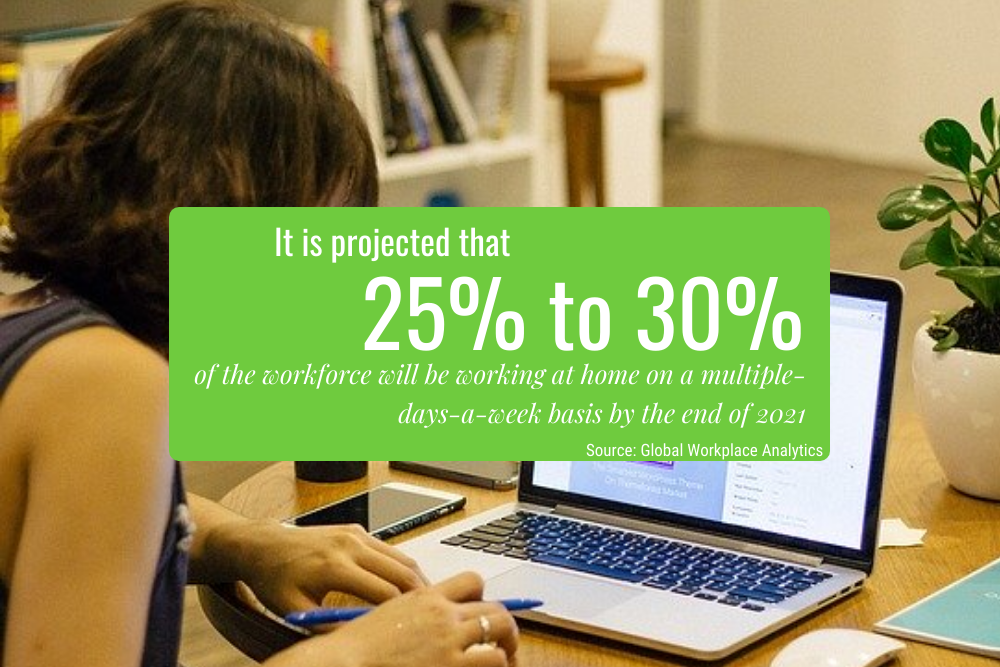Many of us have developed a different outlook on personal hygiene, interacting with people in public, and how we react to the potential spreading of germs. And while some have returned to office environments, that transition has been anything but going back to business as usual. From social distancing measures being taken regarding desk layouts and sharing common areas, to temperature check policies, the current in-office environment is a far cry from what it used to be.
And then there’s those of us who are working remotely due to the flexibility of our industry. For individuals who didn’t use to work remotely on a daily basis, this has been one of the biggest changes the pandemic has brought on. While some have flourished in the work-from-home environment, others have found it difficult to adapt—from staying connected to their team to keeping their own focus and motivation on track—and are looking forward to the days when things go back to “normal”.
While it might be hard to imagine a time when we’ll be free of COVID-19 and all the changes that have come with it, at some point, we will be living in a post-COVID society. But what will it look like? It’s hard to predict what the new normal will be, but here are some modifications to work-life that we’ll likely see.
More People Will Be Working from Home
Many businesses have been reluctant to allow work from home in the past because of concerns over productivity, collaboration, and employees’ ability to handle autonomy. However, with the forced remote work transition imposed on many employers, many of these concerns have proven invalid.
As such, more and more companies are likely to relax their work-from-home policies, with some even making the switch to go fully remote. In fact, Global Workplace Analytics projects that 25-30% of the workforce will be working at home on a multiple-days-a-week basis by the end of 2021. So, what does this mean for you as an employee?
One thing that employers will have to keep in mind when making the post-COVID transition is what their employees need and expect. As an employee, you yield a lot of power and may be able to ask for certain changes to your prior work arrangement, like being able to work remotely. How do you have power in this situation?
Employers will be hoping to meet the least resistance when making the transition back to the office and they’ll want this to happen as quickly and smoothly as possible to get operations back to normal (or as close to pre-COVID production as possible).
And, given that most companies have taken significant hits to their bottom line over the last few months, employee retention will be at the top of their priority list. Losing employees isn’t cheap—turnover can cost anywhere from 16% to 213% of the lost employee’s salary—so don’t be afraid to make your needs and expectations known, respectfully of course. You never know what kind of favorable outcome you may be able to reach, whether that’s working from home more often or being able to take your position completely remote.
For more information on why it’s valuable for employers to make their workers happy, check out this article on employee retention strategies from Sharable for Hires.
Restructuring Roles
Pre pandemic, many roles were thought to be exclusively on-site jobs, especially those that were more managerial or client-focused in nature. While this might still hold true for certain types of positions, it’s been found that many roles can actually handle most or all of their duties just as effectively from home.
However, this realization also comes some restructuring. This could have long-lasting repercussions, both positive and negative depending on your perspective, on professional development. For example, some roles that can be moved to remote positions may have some of their responsibilities adjusted or shifted to another position. Depending on the circumstances, that may be a good or bad thing.
Why is that? Well, by restructuring roles and some of their responsibilities, it could make it harder for certain employees to advance to higher-level positions or develop specific skills that drew them to the position in the first place.
If you find that your role is being restructured post-COVID, you may need to sit down with your boss and discuss how that will impact your opportunities and future at the company.

Reimagining Company Culture
When you think of company culture, you likely think about how coworkers interact in the office environment, which is why many organizations have struggled with maintaining that connectivity through remote work. However, there is no reason why the positive things that define a business’s company culture have to die off. They will just need to be reimagined.
You may have already noticed your company taking strides to do this. From monthly virtual happy hours and workshops to digital water cooler talk, the traditional means of developing company culture have shifted to the virtual world. This is made possible with high-quality video conferencing and instant messaging apps, along with strong leadership.
Post-COVID, we will likely see this continue, combined with the more traditional aspects of company culture (coworker outings, company trips, holiday parties, etc.). Moving forward, it will likely be a hybrid approach that keeps employees connected whether they’re in the office or working off-site, which will be important as more people shift to remote work.
Improved Collaboration
One pandemic-related positive outcome is the adaptability that has been required of both employers and employees to navigate the many changes that were necessary. This has led to a group effort to improve collaboration between team members, departments, and even external parties while working remotely.
While these improvements have not been without their setbacks and challenges—with a huge reliance on and effort of IT departments and resources—they have established lasting solutions. For example—before it was seen as a major imposition to have hybrid conference calls with employees in the office and remote when speaking with clients; however, now it is part of the new normal.
With these refined communication pathways, troubleshooting options, and company-wide-remote-collaboration practices in place, teamwork should be much more refined moving forward.
Adapting to the New Normal
For both employees and employers, adapting to a new work-life normal will be challenging post-COVID. With the above factors in mind, it is likely that employees will hopefully be more satisfied with their circumstances and employers will enjoy the benefits of this shift. The most important thing to keep in mind is to embrace the changes to your work life and find ways to make it work in your interest.
Alexis Maness

Alexis Maness has a Bachelor of Science in Integrated Marketing Communications and is a contributing editor for 365businesstips.com. As a professional content writer, she has over five years of experience and is a contributing writer for several San Diego magazines. Alexis specializes in topics related to business, marketing, finance, and hospitality and tourism.
Become a Mod Girl Marketing Blog Contributor
If you’re interested in submitting a guest post for Mod Girl Marketing, contact us here.



